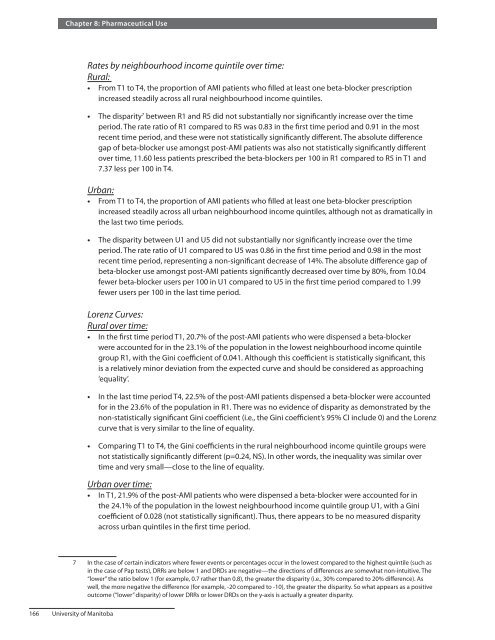Health Inequities in Manitoba: Is the Socioeconomic Gap
Health Inequities in Manitoba: Is the Socioeconomic Gap
Health Inequities in Manitoba: Is the Socioeconomic Gap
Create successful ePaper yourself
Turn your PDF publications into a flip-book with our unique Google optimized e-Paper software.
Chapter 8: Pharmaceutical Use<br />
166 University of <strong>Manitoba</strong><br />
Rates by neighbourhood <strong>in</strong>come qu<strong>in</strong>tile over time:<br />
Rural:<br />
• From T1 to T4, <strong>the</strong> proportion of AMI patients who filled at least one beta-blocker prescription<br />
<strong>in</strong>creased steadily across all rural neighbourhood <strong>in</strong>come qu<strong>in</strong>tiles.<br />
• The disparity 7 between R1 and R5 did not substantially nor significantly <strong>in</strong>crease over <strong>the</strong> time<br />
period. The rate ratio of R1 compared to R5 was 0.83 <strong>in</strong> <strong>the</strong> first time period and 0.91 <strong>in</strong> <strong>the</strong> most<br />
recent time period, and <strong>the</strong>se were not statistically significantly different. The absolute difference<br />
gap of beta-blocker use amongst post-AMI patients was also not statistically significantly different<br />
over time, 11.60 less patients prescribed <strong>the</strong> beta-blockers per 100 <strong>in</strong> R1 compared to R5 <strong>in</strong> T1 and<br />
7.37 less per 100 <strong>in</strong> T4.<br />
Urban:<br />
• From T1 to T4, <strong>the</strong> proportion of AMI patients who filled at least one beta-blocker prescription<br />
<strong>in</strong>creased steadily across all urban neighbourhood <strong>in</strong>come qu<strong>in</strong>tiles, although not as dramatically <strong>in</strong><br />
<strong>the</strong> last two time periods.<br />
• The disparity between U1 and U5 did not substantially nor significantly <strong>in</strong>crease over <strong>the</strong> time<br />
period. The rate ratio of U1 compared to U5 was 0.86 <strong>in</strong> <strong>the</strong> first time period and 0.98 <strong>in</strong> <strong>the</strong> most<br />
recent time period, represent<strong>in</strong>g a non-significant decrease of 14%. The absolute difference gap of<br />
beta-blocker use amongst post-AMI patients significantly decreased over time by 80%, from 10.04<br />
fewer beta-blocker users per 100 <strong>in</strong> U1 compared to U5 <strong>in</strong> <strong>the</strong> first time period compared to 1.99<br />
fewer users per 100 <strong>in</strong> <strong>the</strong> last time period.<br />
Lorenz Curves:<br />
Rural over time:<br />
• In <strong>the</strong> first time period T1, 20.7% of <strong>the</strong> post-AMI patients who were dispensed a beta-blocker<br />
were accounted for <strong>in</strong> <strong>the</strong> 23.1% of <strong>the</strong> population <strong>in</strong> <strong>the</strong> lowest neighbourhood <strong>in</strong>come qu<strong>in</strong>tile<br />
group R1, with <strong>the</strong> G<strong>in</strong>i coefficient of 0.041. Although this coefficient is statistically significant, this<br />
is a relatively m<strong>in</strong>or deviation from <strong>the</strong> expected curve and should be considered as approach<strong>in</strong>g<br />
‘equality’.<br />
• In <strong>the</strong> last time period T4, 22.5% of <strong>the</strong> post-AMI patients dispensed a beta-blocker were accounted<br />
for <strong>in</strong> <strong>the</strong> 23.6% of <strong>the</strong> population <strong>in</strong> R1. There was no evidence of disparity as demonstrated by <strong>the</strong><br />
non-statistically significant G<strong>in</strong>i coefficient (i.e., <strong>the</strong> G<strong>in</strong>i coefficient’s 95% CI <strong>in</strong>clude 0) and <strong>the</strong> Lorenz<br />
curve that is very similar to <strong>the</strong> l<strong>in</strong>e of equality.<br />
• Compar<strong>in</strong>g T1 to T4, <strong>the</strong> G<strong>in</strong>i coefficients <strong>in</strong> <strong>the</strong> rural neighbourhood <strong>in</strong>come qu<strong>in</strong>tile groups were<br />
not statistically significantly different (p=0.24, NS). In o<strong>the</strong>r words, <strong>the</strong> <strong>in</strong>equality was similar over<br />
time and very small—close to <strong>the</strong> l<strong>in</strong>e of equality.<br />
Urban over time:<br />
• In T1, 21.9% of <strong>the</strong> post-AMI patients who were dispensed a beta-blocker were accounted for <strong>in</strong><br />
<strong>the</strong> 24.1% of <strong>the</strong> population <strong>in</strong> <strong>the</strong> lowest neighbourhood <strong>in</strong>come qu<strong>in</strong>tile group U1, with a G<strong>in</strong>i<br />
coefficient of 0.028 (not statistically significant). Thus, <strong>the</strong>re appears to be no measured disparity<br />
across urban qu<strong>in</strong>tiles <strong>in</strong> <strong>the</strong> first time period.<br />
7 In <strong>the</strong> case of certa<strong>in</strong> <strong>in</strong>dicators where fewer events or percentages occur <strong>in</strong> <strong>the</strong> lowest compared to <strong>the</strong> highest qu<strong>in</strong>tile (such as<br />
<strong>in</strong> <strong>the</strong> case of Pap tests), DRRs are below 1 and DRDs are negative—<strong>the</strong> directions of differences are somewhat non-<strong>in</strong>tuitive. The<br />
“lower” <strong>the</strong> ratio below 1 (for example, 0.7 ra<strong>the</strong>r than 0.8), <strong>the</strong> greater <strong>the</strong> disparity (i.e., 30% compared to 20% difference). As<br />
well, <strong>the</strong> more negative <strong>the</strong> difference (for example, -20 compared to -10), <strong>the</strong> greater <strong>the</strong> disparity. So what appears as a positive<br />
outcome (“lower” disparity) of lower DRRs or lower DRDs on <strong>the</strong> y-axis is actually a greater disparity.


